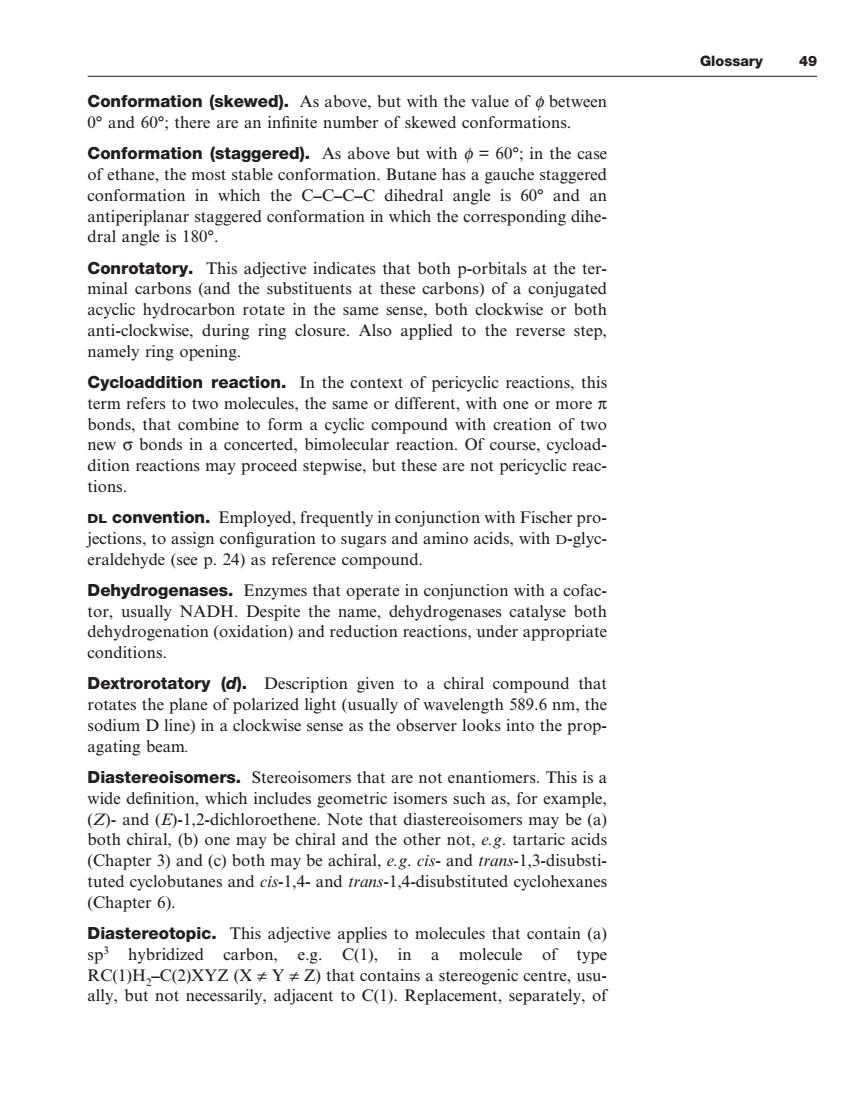正在加载图片...

Glossary 49 Conformation (skewed).As above,but with the value of between O°and6o°:there are an infinite number of skewed conformations. Conformation (staggered).As above but with =60;in the case of ethane the most stable conformation butane has a gauche staggered conformation in which the C-C-C-C dihedral angle is 60and an antiperiplanar staggered conformation in which the corresponding dihe- dral angle is 180 Conrotatory.This adjective indicates that both p-orbitals at the ter. minal carbons (and the substituents at these carbons)of a conjugated acyclic hydrocarbon rotate in the same sense,both clockwise or both anti-clockwise,during ring closure.Also applied to the reverse step, namely ring opening. Cycloaddition reaction.In the context of pericyclic reactions,this refers to two ules,the same or different with one or me bonds. that combine to form a cyclic compound with creation of two new o bonds in a concerted,bimolecular reaction.Of course,cycload- dition reactions may proceed stepwise,but these are not pericyclic reac- tions. DL convention.Employed,frequently in conjunction with Fischer pro jections,to assign configuration to sugars and amino acids,with D-glyc- eraldehyde (see p.24)as reference compound. Dehydrogenases.Enzymes that operate in conjunction with a cofac- usually NADH.Despite the nar dehyd conditions Dextrorotatory (d).Description given to a chiral compound that rotates the plane of polarized light (usually of wavelength 589.6 nm,the sodium D line)in a clockwise sense as the observer looks into the prop agating beam Diastereoisomers.Stereoisomers that are not enantiomers.This is a wide definition,which includes geometric isomers such as,for example, (Z)-and (E)-1,2-dichloroethene.Note that diastereoisomers may be (a) both chiral,(b)one may be chiral and the other not,e.g.tarta ic acids (Chapter 3)and (c)both may be achiral,e.g.cis-and trans-1,3-disubsti- tuted cyclobutanes and cis-1,4-and trans-1,4-disubstituted cyclohexanes (Chapter 6). Diastereotopic.This adjective applies to molecules that contain (a) CODH.COXYZY that comtains a stereogemie sentre.usu on, e.g. in a molecule type ally,but not necessarily,adjacent to C(1).Replacement,separately,of Conformation (skewed). As above, but with the value of φ between 0° and 60°; there are an infinite number of skewed conformations. Conformation (staggered). As above but with φ = 60°; in the case of ethane, the most stable conformation. Butane has a gauche staggered conformation in which the C–C–C–C dihedral angle is 60° and an antiperiplanar staggered conformation in which the corresponding dihedral angle is 180°. Conrotatory. This adjective indicates that both p-orbitals at the terminal carbons (and the substituents at these carbons) of a conjugated acyclic hydrocarbon rotate in the same sense, both clockwise or both anti-clockwise, during ring closure. Also applied to the reverse step, namely ring opening. Cycloaddition reaction. In the context of pericyclic reactions, this term refers to two molecules, the same or different, with one or more π bonds, that combine to form a cyclic compound with creation of two new σ bonds in a concerted, bimolecular reaction. Of course, cycloaddition reactions may proceed stepwise, but these are not pericyclic reactions. DL convention. Employed, frequently in conjunction with Fischer projections, to assign configuration to sugars and amino acids, with D-glyceraldehyde (see p. 24) as reference compound. Dehydrogenases. Enzymes that operate in conjunction with a cofactor, usually NADH. Despite the name, dehydrogenases catalyse both dehydrogenation (oxidation) and reduction reactions, under appropriate conditions. Dextrorotatory (d). Description given to a chiral compound that rotates the plane of polarized light (usually of wavelength 589.6 nm, the sodium D line) in a clockwise sense as the observer looks into the propagating beam. Diastereoisomers. Stereoisomers that are not enantiomers. This is a wide definition, which includes geometric isomers such as, for example, (Z)- and (E)-1,2-dichloroethene. Note that diastereoisomers may be (a) both chiral, (b) one may be chiral and the other not, e.g. tartaric acids (Chapter 3) and (c) both may be achiral, e.g. cis- and trans-1,3-disubstituted cyclobutanes and cis-1,4- and trans-1,4-disubstituted cyclohexanes (Chapter 6). Diastereotopic. This adjective applies to molecules that contain (a) sp3 hybridized carbon, e.g. C(1), in a molecule of type RC(1)H2 –C(2)XYZ (X ≠ Y ≠ Z) that contains a stereogenic centre, usually, but not necessarily, adjacent to C(1). Replacement, separately, of Glossary 49